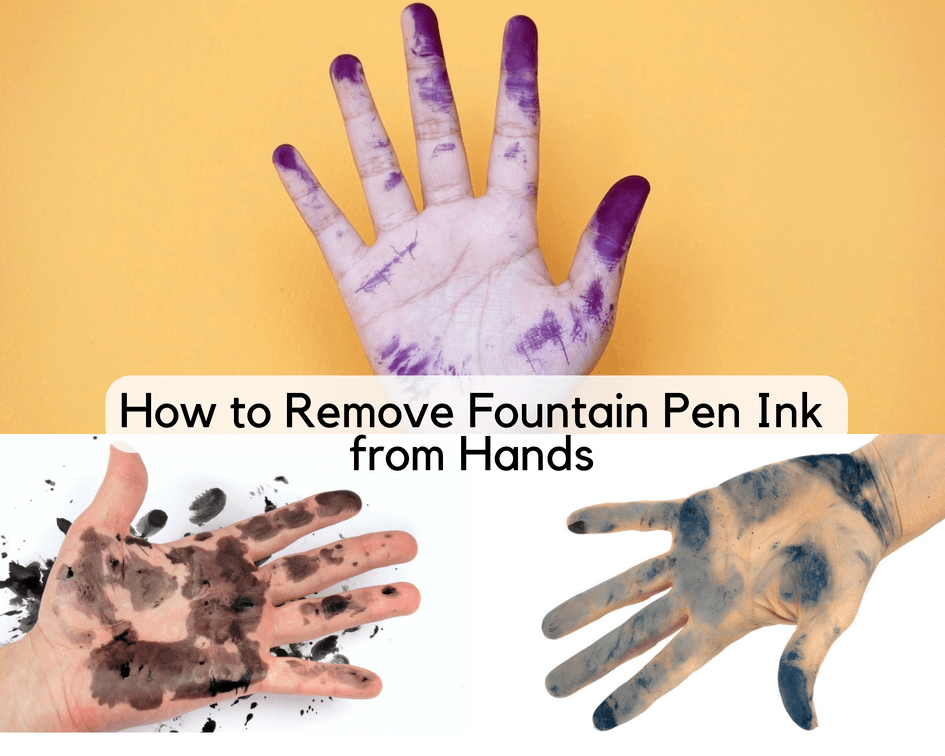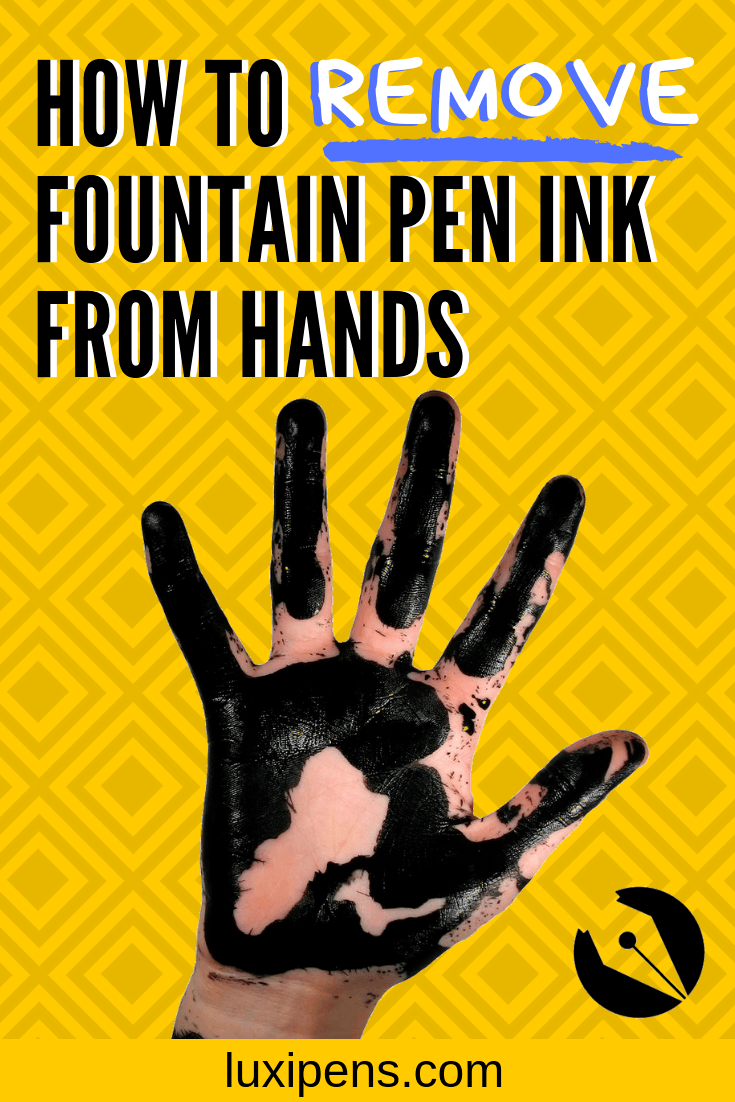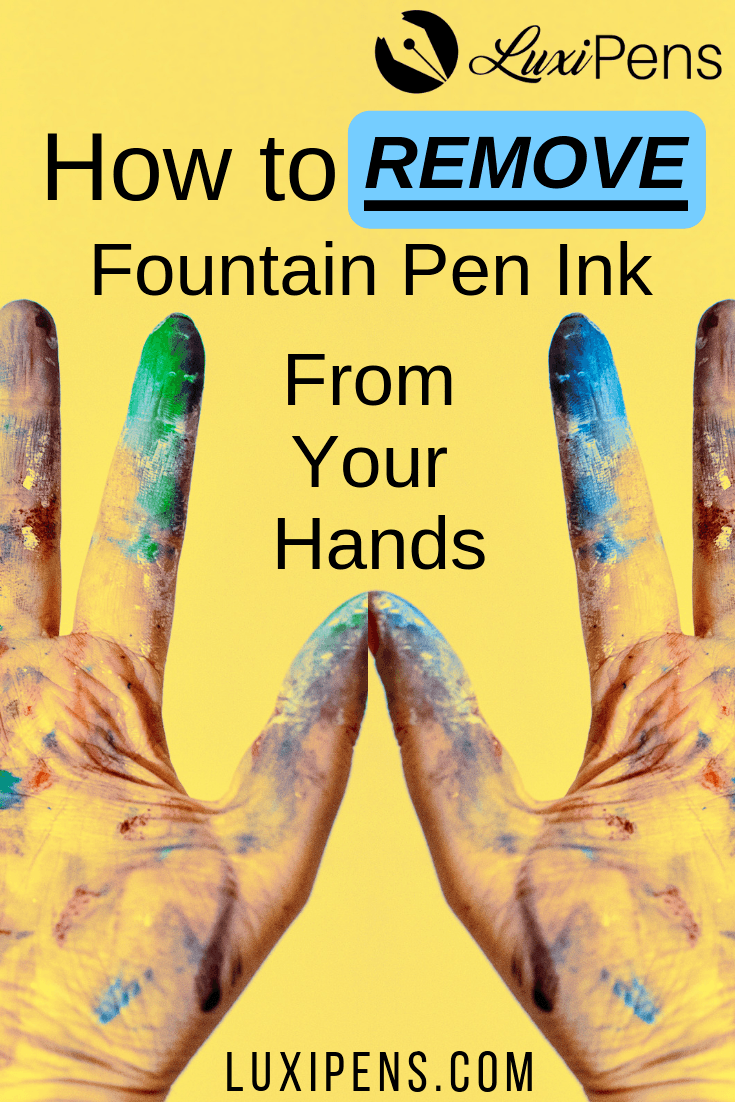When writing with a fountain pen, getting ink on your hands is an unexpected mishap. Although fountain pens do not significantly leak unless there is internal damage, even the most experienced connoisseurs can spill bottled ink during a refill or smudge a freshly written sentence. Removing fountain pen ink from your hands doesn’t have to be frustrating.
There are several methods to effectively remove fountain pen ink stains with commercial products, everyday household items, and natural remedies. Most of the products are gentle on the skin and easily accessible.

What is Fountain Pen Ink Made Of?
Most fountain pen inks contain only water and dye. This water-soluble ink flows faster than oil or gel-based inks when applying pressure to the nib. Fountain pen ink takes longer to dry, increasing the likelihood of smudging and staining.
fountain pen ink ingredients
Water | |
Dyes | |
Other Ingredients |
Other fountain pen inks that contain lubricants, oils, and solvents have stronger chemical bonds, making ink stains more resistant. Acids and alkalis do not affect the compounds, so cleaning requires more effort to break down the stain. Despite these extra additives, the ink will not harm you if it gets on your skin.
Possible Causes of Ink Stains
How does fountain pen ink stain your skin, clothes, and furniture? Writers can stain their skin and belongings by spilling ink during refills or wiping excess ink from the nib after charging.
For more detailed information on refilling, inking, or charging a fountain pen, read our article:
“How to Put Ink in a Fountain Pen”
Hand stains are often the result of smudging a newly written sentence. This is more common in left-handed writers because when writing left-to-right, they move their hand over the script they've previously written.
Tips for left-handed fountain pen writers in our article,
“How to Write with a Fountain Pen Left-Handed.”
Those new to the fountain pen are inexperienced in handling and maintenance, which can lead to ink stains. Fountain pens should always be stored with the nib facing up or in a fountain pen case. Keeping the nib in a downward position places pressure on the nib and pools ink at the tip. Improper storage during airplane travel can also cause leaks due to the pressure variations during takeoff and landing.
For more detailed information on fountain pen storage, read our article:
“How to Store a Fountain Pen”
Preventing Fountain Pen Stains
Writing with care and taking certain precautions can avoid ink stains on your hands. Some writers create a barrier between their hands and the fresh ink on the paper with either glue or a piece of paper. Smoothing a thin layer of adhesive over your palm and allowing it to dry makes a protective layer over the skin. Other writers will place another piece of paper under their hand before they start writing. Accidental smudges will get on the dried glue or paper, protecting your hands from stains. Wearing a pair of surgical gloves during refilling can prevent stains during refilling.
How to Remove Fountain Pen Ink from Skin
When fountain pen ink stains the epidermis (outer protective layer of skin), standard handwashing procedures will remove the stain over time. Washing with soap and water takes multiple attempts as the outer layer of skin sloughs off naturally. Several household remedies are useful, and they probably products you already have in your home.
Household Remedies for Removing Ink from Skin
Alcohol-based hand sanitizers will clean fountain pen ink stains better than soap and water. Rub the sanitizer on the ink stain in a circular motion. For more stubborn stains, use a clean cloth to apply it.
Baby oil breaks down the oils in fountain pen ink, which makes the stain effortless to remove. Rub baby oil in a circular motion and rinse with plain water. Use a paper towel or clean cloth to help with harder ink stains.
Borax is a granulated substance often used as a laundry booster. It’s abrasive enough to slough off the stained skin. Use Borax mixed with liquid soap or water to clean ink stains. Although it’s a safe cleaning option, people with sensitive skin have reported minor irritation.
Dishwashing liquid dissolves oil, so it lifts ink stains easily. Wash the ink stain with dishwashing liquid and water.
Dr. Bronner’s is a castile soap that can get rid of the oils in fountain pen ink so you can wash the stain easier than plain soap and water. A gentle, organic product commonly used on babies, it is perfect for those who have sensitive skin. Wash the stain with Dr. Bronner’s soap and rinse with water. Repeat until the stain is gone.
Hairspray contains alcohol that dissolves fountain pen ink. Apply hairspray directly onto your stained skin and scrub the spot with a damp cloth in a circular motion.
Milk has natural properties that easily separate the oils in fountain pen ink. Rub some milk into your stained skin with a clean, dry cloth until the stain disappears.
Shampoo is an excellent solution for removing fountain pen ink from your hair, hands, and nails. To remove stains, use shampoo like soap and wash your hands with it. If you have ink under your fingernails, following your usual hair-washing routine will completely immerse your fingers in shampoo and dissolve the stains.
Tea bags are a standard household item that can gently remove ink stains. Use a steeped, room-temperature tea bag to scrub the ink off your skin. Oils in the tea along with the semi-abrasive material of the bag lift the stain. Try not to be too aggressive, or the tea bag will break, spilling the contents.
Tea tree oil is an all-natural remedy perfect for those avoiding chemical products. Sprinkle a of few drops of this essential oil on a dry cloth to scrub the stain, or use a fingernail brush for more stubborn spots. This method may take a few attempts to remove, but it is gentle on sensitive skin types.
Toothpaste comes in many formulas, but the baking soda in non-gel toothpaste lifts ink off of your skin. Rub a dollop of the toothpaste onto the entire ink stain for a few seconds before removing with plain water or a damp cloth.
Vegetable shortening and butter break down the oil in fountain pen ink. What is left behind is the liquid of the ink, which will come off as the shortening or butter is cleaned off your skin. Rub butter or shortening on the ink stain in a circular motion until the stain begins to fade, then clean off the grease with a dry paper towel.
White vinegar with acetic acid dissolves the oil in fountain pen ink easier than plain water. Wet the stain with vinegar and scrub with a paper towel. This will slough away the outer layer of skin and get rid of the spot.
Best Commercial Products for Getting Ink Off Your Skin
Several commercial products are available for removing ink stains, but they aren’t all-natural products. Those who desire natural products or have extremely sensitive skin should look for hypoallergenic options, such as all-natural cleansers.
Best Commercial Products for Getting Ink Off Your Skin
Amodex is one of the popular choices among fountain pen users. Rub a small amount of the solution on your skin and use a nail brush or old toothbrush to scrub the stain. Rinse the spot clean with warm water.
Fast Orange is made with aloe, lanolin, and similar conditioners that clean ink without harming your skin as much as other products. There are no harsh chemicals or noxious odors. Follow the product's directions for the best results.
GoJo Hand Cleaner removes grease, so it will dissolve the oil in ink. It is available for purchase at most home repair stores and comes in different forms, including lotions, gels, and wipes.
Lava soap is more abrasive than regular soap. It contains pumice to scrub away stubborn stains like ink, grease, paint, and similar inorganic substances that ordinary soap can’t clean. Available for purchase at home repair stores, use lava soap according to the directions for best results.
Mr. Clean Magic Eraser is a relatively inexpensive cleaning product that requires no additional soaps or water. Rub the Magic Eraser on the ink stain and watch it disappear. The non-abrasive sponge is safe for most skin types.
ReDuRan lifts difficult stains such as ink, paint, and other dyes. Rub into your skin and massage it in until the ink fades. Rinse the area with soap and water once the ink is gone.Harsher Commercial Cleansers
There are some harsher cleansers available to remove fountain pen ink, but these methods can also damage the skin without careful application. For best results, follow the instructions carefully. If you have sensitive skin or other allergies, do a spot test on another area of the skin before using these products.
Harsher Commercial Cleansers
Astonish Cream Cleaner with Bleach cleans stubborn kitchen stains like grease and mildew. It works well to get rid of fountain pen ink, but can cause significant irritation if not used carefully.
Bleach used in small, diluted amounts can clean ink-stained skin. Mix ½ teaspoon of bleach with a cup of water to remove the stain. Immediately wash your hands with soap and water to avoid skin irritation or allergic reactions.
Rubbing alcohol and acetone, commonly found in nail polish remover, can clean ink from your hands, nails, and other areas, but it can be harsh on sensitive skin. Apply with a dry cloth and wipe away. Wash your hands with soap and water to protect against skin irritation.
How to Remove Ink from Children’s Skin
If your children play near your workspace, they may get fountain pen ink on their skin. Removing fountain pen ink from babies and children requires gentle cleansers because their skin is more sensitive than adults. Use natural remedies or products without harsh chemicals, (such as natural soaps, butter, or milk), to clean the ink off of your child’s skin.
Strong natural products, (such as tea tree oil), may be too strong for your child’s skin, even though it is all-natural. To avoid adverse reactions, mix tea tree oil with a base like baby oil or extra virgin olive oil. Complete a spot test by applying the product to a small patch of skin to check for allergic reactions or sensitivities before using the product to clean the ink stain.
How to Remove Ink from Nails
Handling bottled fountain ink commonly causes ink stains on or under the fingernails. Any of the methods described above for removing ink from the skin are just as effective for removing ink from nails. Soaking the fingertips in one of the gentler solutions (such as vinegar or milk) can speed along the process by completely dissolving the ink compounds. Tea tree oil and hairspray can dissolve ink stains without damaging nail polish. Using a nail brush will gently buffer the skin to remove the stain more quickly.
How to Remove Ink from Hair
Although getting fountain pen ink in your hair is less frequent, it does happen. Touching your hair with freshly- stained hands can transfer the wet ink, or you can accidentally dip loose, long hair into an open ink bottle. These stains can be difficult to clean because porous hair fibers soak up ink easily. The best way to get ink out of your hair is to wash your hair with your usual shampoo. Malibu hair treatments that lift ink stains from permed or color-treated hair are available at most beauty supply stores.
How to Remove Fountain Pen Ink from Your Pet
Our pets are such a part of our daily lives that it is inevitable that they may come into contact with fountain pen ink. Animals have different skin properties than humans, so commercial and harsh cleansers can harm them. Gentler methods such as dish soap, pet shampoo, or baking soda pastes (three parts baking soda mixed with one -part plain water) will remove ink safely. If you want to avoid using products on your pet, carefully trim the stained fur away.
How to remove fountain pen ink from clothes or fabric
Removing fountain pen ink from clothing, furniture, or carpeting is different than treating skin or hair. Use gentle household cleaners such as dishwashing liquid, baking soda, or white vinegar. Gently dab or pat the stain with a soft cloth or non-abrasive sponge to clean stains without ruining the fabric.
When I first began using my fountain pen on a regular basis, I was extra careful not to stain my hands with the ink. I was diligent in keeping the pen away from my cats, who like to sit on my desk during my writing sessions, and I replaced ink cartridges with care. After I ran out of ink cartridges, I used the converter to refill my pen with bottled ink. During this process, I stained my fingertips with ink.
Unaware of the multiple cleaning methods available to me (most of them with items I already had in my home), I consistently washed my hands, waiting for the stains to disappear. I have extremely sensitive skin, so I was wary of using any other cleaners other than hand soap. Now that I know there are gentle methods to remove ink stains, my worry about staining my hands is a thing of the past.
Please comment and share below
Although this article is comprehensive, the information presented is only as accurate the material we were able to source, and is by no means exhaustive, authoritative, nor complete. If you have additions or corrections which you believe should be included in this page, we invite you to include your comments below. Please consider sharing both the citation as well as the new information with us. Our goal is to foster an open dialogue with our readers.
Please also share the article with fountain pen or ballpoint pen enthusiasts. We appreciate you spreading the word!




